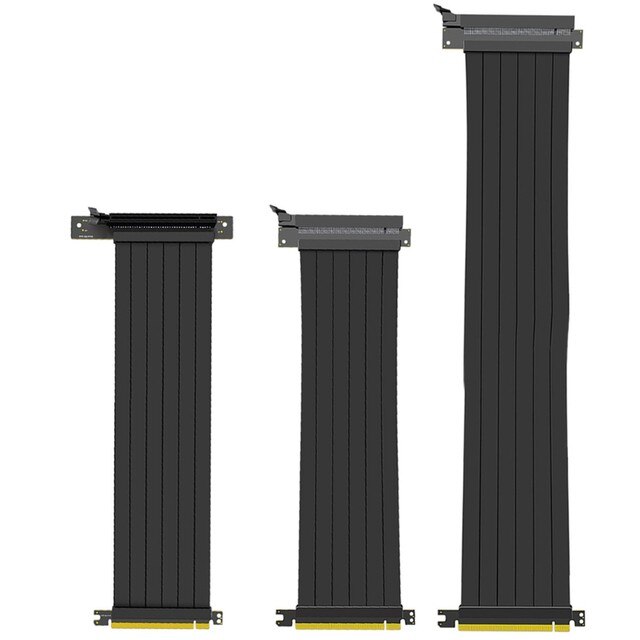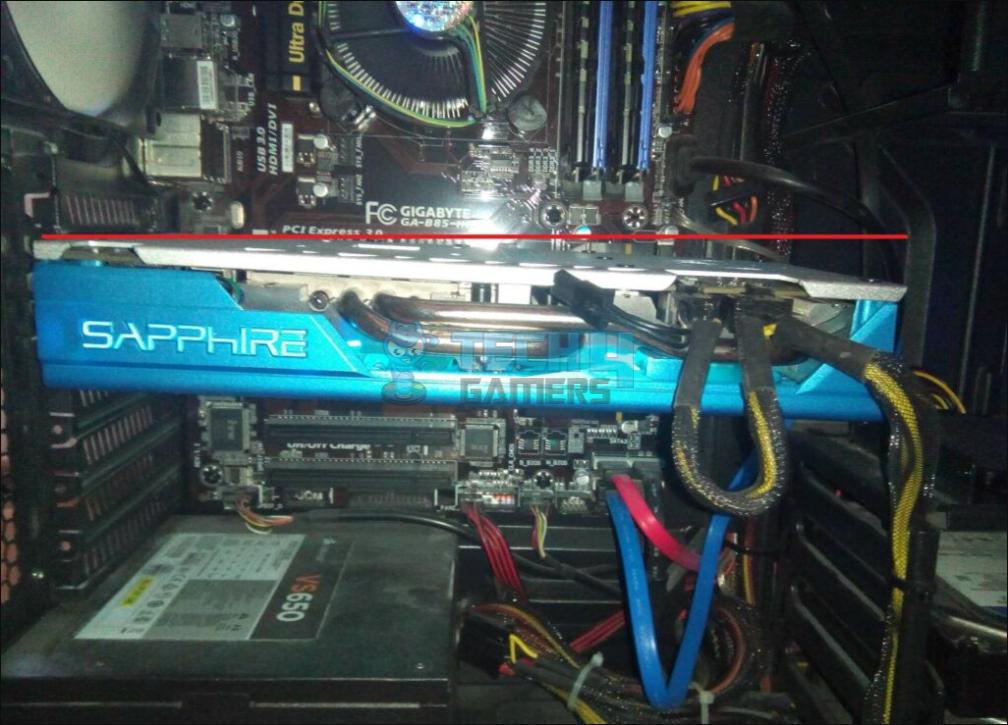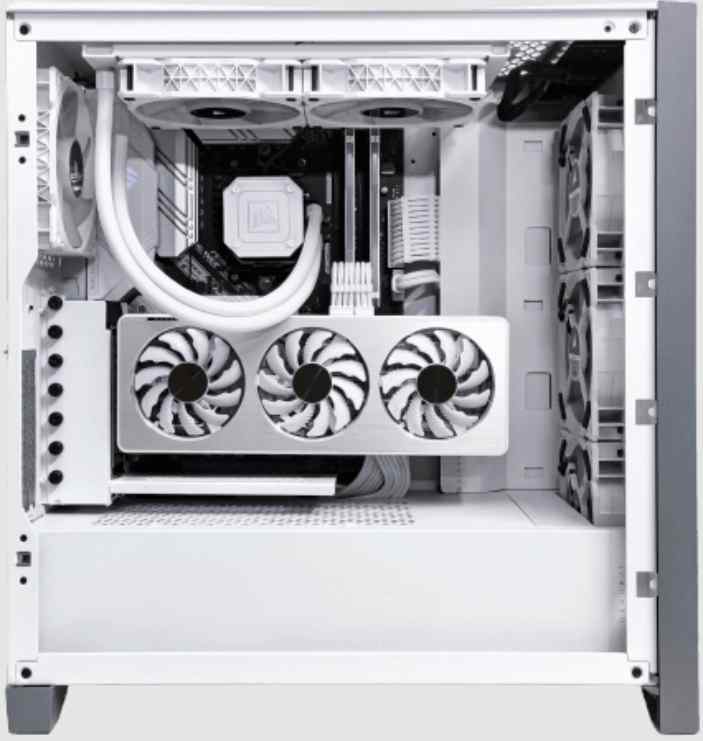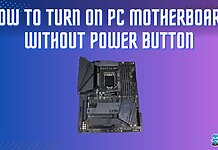Vertically mounting your GPU has become a growing trend in recent years. However, there are a few pitfalls you need to watch out for before you attempt to vertical mount your GPU, as you can damage the component otherwise.
Key Takeaways
- Mounting graphics cards vertically can be done for a few reasons, the most prominent being to make the PC look more stylish.
- Most PC cases and motherboards, especially older ones, are not designed for vertically mounted GPUs. So, hardware compatibility needs always to be kept in mind.
- Vertically mounting the GPU can be done in a few different ways, with the simplest being to use an aftermarket vertical GPU mount bracket.
Vertical GPU Mounting Bracket
A mounting bracket lets you install the graphics card in a custom position. The bracket fits into the expansion slot backplate of the PC case.

This method does not require any additional space in the case and can look very aesthetically pleasing. Once the mounting bracket is in place and the GPU is attached to it, you only need to attach a PCIe riser cable to the bracket and insert it into the motherboard’s PCIe slot.

If your case does not have a vertical GPU mounting bracket, you can make a custom bracket using materials like aluminum or acrylic. This method requires some DIY skills and tools, but it can be a great option to save money and have a unique look for your build.
How To Vertical Mount A GPU
Now that you know the different ways to mount your graphics card vertically, here are the steps to follow to mount your graphics card vertically with a mounting bracket:
- Take off as many expansion slot backplates on the PC case as the vertical GPU bracket requires.
- Install the bracket into the case’s expansion slots.
- Then, simply press the GPU into the slot on the bracket.
- Connect the PCIe riser cable from the bracket to the motherboard’s top x16 PCIe slot.
- Connect the one or multiple 6-pin or 8-pin power cables to the graphics card as you would with a horizontally mounted GPU.
- Test the system once the graphics card is mounted and all cables are connected to ensure everything works correctly.
If you are only using a riser cable, then first make sure the length of the cable is appropriate. It should be long enough to easily reach where you wish to mount your GPU without pulling on the PCIe slot on the motherboard.
Difference Between Horizontal And Vertical Mounting
Traditionally, graphics cards are mounted horizontally in a computer case. This orientation allows for easy installation, maintenance, and access to ports. However, the graphics card’s orientation can affect the system’s cooling performance.
When mounted horizontally, the graphics card’s fan will face downwards, causing hot air to accumulate around the GPU. This can lead to higher temperatures, affecting the graphics card’s performance and lifespan and causing issues such as GPU artifacting.

According to my understanding, vertical mounting of the GPU can improve airflow and cooling in the system. When mounted vertically, the graphics card’s fan faces toward the side of the case. This orientation allows for better airflow and can help dissipate the heat generated by the graphics card more efficiently.
GPU Sagging
When a GPU is mounted without a bracket, the weight of the GPU causes it to sag in the PCIe slot, potentially one day simply making it rip out of the slot due to its sheer weight. With a vertical mount, the problem of GPU sag becomes virtually non-existent.

So, your case and panel type are critical in determining whether or not you should vertically mount your GPU. Before proceeding further, check out the best GPU overclocking software in case you want to boost its performance.
Problems With Mounting GPU Vertically
As per my experience, the biggest problem when vertically mounting a GPU is to fit it in the case. Not all cases or GPUs work vertically. You might need to tinker with the GPU or remove parts. Make sure there’s space for the GPU’s height in your case. Remember, a vertical GPU covers other slots. Use a cable for flexibility.

Frequently Asked Questions
No, vertically mounted GPUs don’t perform worse than typically mounted GPUs. They can even perform better because of greater airflow.
You need to have enough vertical space inside the case for the GPU. The PC expansion slot backplate has to accommodate the vertical mount bracket if that is being used to mount the graphics card vertically.
Vertically mounting a GPU eliminates GPU sag significantly as long as the vertical mount bracket is not cheap and flimsy. This is especially true if it is not touching the PC case and is lifted in the air.
A liquid-cooled GPU can be mounted vertically like a regular GPU.
Related Articles:
- How To Remove GPU From The Motherboard [Explained]
- Does Overclocking Reduce GPU’s Lifespan?
- How To Lower GPU Temperature? [Ultimate Guide]
Thank you! Please share your positive feedback. 🔋
How could we improve this post? Please Help us. 😔
[How To’s & Guides Editor]
Haddi has been in the Gaming and tech Space for over 10 Years Now; he has worked on notable websites like eXputer, Gamepur, Gear Siege, Gearnuke, and plenty more. He is an expert at Games & PC Hardware; you can expect him to solve any problem. People often joke, that if there is any problem anyone can solve, Haddi can solve it faster. Currently, Haddi writes and manages a Team of Experts at Tech4Gamers.
Contact: Haddi@tech4gamers.com


 Threads
Threads![How To Record Guitar To PC? [10 Methods] How to record guitar to PC?](https://tech4gamers.com/wp-content/uploads/2023/05/HOW-TO-6-218x150.jpg)
![How To Check What Motherboard I Have? [All Methods] What Motherboard Do I Have](https://tech4gamers.com/wp-content/uploads/2022/11/What-Motherboard-Do-I-Have-218x150.jpg)
![How To Lock Computer With Keyboard? [All Methods] How to lock computer screen with keyboard](https://tech4gamers.com/wp-content/uploads/2023/07/HOW-TO-2-1-218x150.jpg)

![How To Unlock Keyboard On HP Laptop? [SOLVED] How To Unlock Keyboard On HP Laptop](https://tech4gamers.com/wp-content/uploads/2022/12/How-To-Unlock-Keyboard-On-HP-Laptop-218x150.jpg)